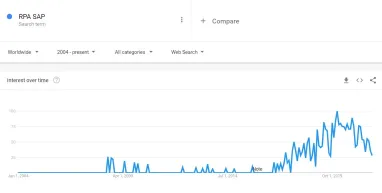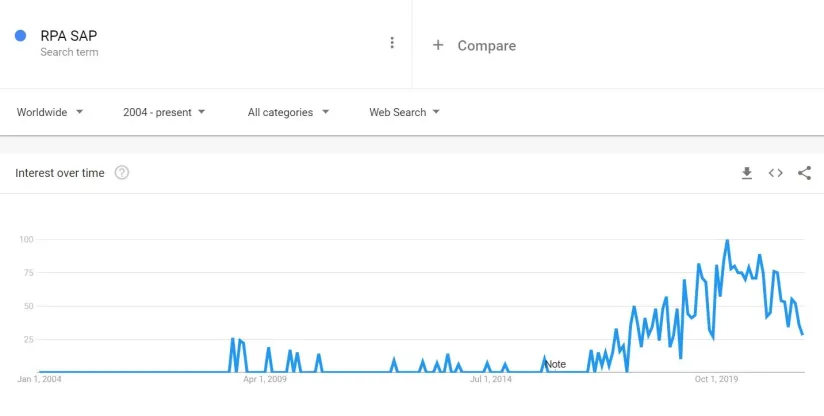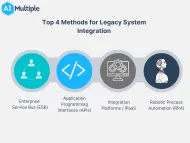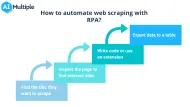Top 20 Use Cases & Examples of RPA in SAP in 2024


Most of SAP processes are manual and repetitive, such as accounting processes, transaction management, and reporting. This makes RPA a great candidate for automating SAP and redirecting resources to higher-value activities and processes.
For context, Enterprise Resource Planning (ERP) integrates all processes in an enterprise such as finance, manufacturing, HR, supply chain, services, procurement, into a single system. Systems Applications and Products (SAP) is the most commonly used ERP software on the market today. SAP software include applications or “modules” such that each module focuses on a specific area in the business. Depending on the industry, a combination of SAP modules is used to meet the company’s need. SAP software help industries in:
- Collecting consistent data from all the different sources in the business
- Sharing this data among different departments in the business in a single database
- Having visual presentations and deeper insights and analytics for a better decision-making process
RPA applications in SAP
RPA bots can tackle data entry, report generation, alerts, and other rule-based tasks in almost all of the departments connected by SAP software.
1. Finance and Accounting
Finance modules in SAP enable up-to-date financial insights, fast and accurate processes, and strategic use of financial data. RPA bots can automate many tasks in SAP finance modules, such as:
- Accounting:
- Account Payable (AP) process handles receiving, processing, and paying money owed by the company. A highly automatable process by RPA which we covered in our article AP automation.
- Account receivable (AR) process handles collecting money owed to the company. Similar to AP, AR is highly automatable. AR is the last step in the order management process and you can read how AR is automated in our article on order management for businesses.
- Account reconciliation: Matching figures in the general ledger against the figures in the bank statement
- Financial close produces a report of all the previous processes. This informs stakeholders of the company’s financial performance over a specific time-period.
For some other ERP solutions with AP automation capabilities, check:
- Dynamics 365 in Accounts Payable Automation: In-Depth Review
- NetSuite Accounts Payable (AP) Automation in 2024
- Blackbaud Accounts Payable (AP) Automation in ’24: In-Depth Review
- Sage Accounts Payable (AP) Automation in ’24
Feel free to read our article RPA use cases in accounting to learn more about automation potential in accounting.
- Financial planning:
- SAP software focuses on analyzing financial trends and uniting plans and actuals in one financial system.
- RPA bots can gather data about financial trends and forecasts to allow for faster analysis, budgeting, and operational planning.
- Treasury:
- SAP software allows for the user to analyze cash flow, capital, payments, and financial risks from KPIs, reports, and liquidity plans.
- RPA bots in SAP can automate cash positioning (predicting expected payments and expected receipts of the day) and extracting reports from profit and loss (P&L) statements.
For more on RPA in finance, read our article on RPA finance use cases.
2. Interface and Connection
SAP systems need to be integrated to other systems. SAP environments may be connected to different SAP and non-SAP systems in one enterprise through Interfaces. These interfaces can be connected via:
- SAP Process Integration (SAP PI), a platform integrating SAP and non-SAP applications to allow the exchange of data between internal softwares in the enterprise and/or external systems outside the enterprise.
- SAP Process Orchestration (SAP PO), a more advanced version of PI that combines process management and integration features of SAP, as well as SAP business rules management features.
The connection of these SAP and non-SAP interfaces helps in processing numerous transactions on a daily basis. Feedback about errors in these transactions is not easily detected unless a specific transaction has not been completed. In this case, the user is required to identify the problem, where it happened, and how to fix it.
Implementing RPA to monitor interfaces can allow for continuous inspection of processes and connections, to identify any errors and report them to the user for immediate response.
Businesses may also leverage workload automation (WLA) tools for monitoring interfaces because WLA enable the execution, monitoring, and logging of processes across multiple business platforms from a centralized point, thus, providing a holistic view of all processes running.
3. Recruiting
Recruiting is a highly automatable task in SAP because of its mundane nature. The recruitment process in SAP revolves around the following steps:
- Requisition management is done by the management and recruiting team and is not a good candidate for automation. It includes determining:
- Which positions need to be filled in the company
- How candidates are going to be selected
- How candidates will be assessed
- Job posting aims to attract candidates by posting job applications. If applications are going to be posted in to pre-determined job portals, then this task can be automated. However, as the company reaches out to new types of talent, this needs to be considered. For example, Linkedin can be a great job board for a business development candidate but honeypot can be better for finding software development talent.
- Candidate outreach includes searching in talent pools or publications in different social media . This step can be automated by programming the bots to scan talent pools and databases for qualified candidates and outreach them with automatically customized messages. However, this involves NLP capabilities from the RPA bot and applications from RPA marketplaces may be necessary to build such a capable bot.
- Application entryand tracking, accepting application coming from different sources such as emails and LinkedIn messages.
- RPA bots can automate this task by collecting, processing and organizing candidate information to be stored in the company’s ERP system.
- RPA chatbots can further improve this process by sending automated replies to candidates as follow up, as well as answering simple questions from candidates and providing application instructions.
- Job offer creation and sending, preparing individualized job offers, which can be time-consuming due to variation in candidate’s information.
- In companies where a similar offer template is shared with many employees, RPA bots can automate the job offer creation process by:
- Preparing offers with each candidate’s information
- Process offer letters faster and with fewer errors
- In companies where offers vary significantly, hiring process can be completed manually. This is one of the most important processes in the company and if customizing offers are necessary to win the talent war, companies should do that.
- In companies where a similar offer template is shared with many employees, RPA bots can automate the job offer creation process by:
For more on automation in HR, feel free to read our articles:
- What is RPA for HR? – Top 9 RPA use cases in HR
- Applicant Tracking Systems (ATS) are specialized systems that automate most of these tasks in an end-to-end manner. Rather than building their specific automation systems, companies may find it easier to adopt an ATS.
4. Sales
SAP modules for sales include many tasks that can be automated by RPA, such as:
- Processing sales orders (requests, conditions, and confirmations)
- Data management (sales and contracts documentation entry, update, and validation)
- Error corrections.
According to Statista, ±$7 trillion e-commerce B2B sales orders are processed. Given the slower growth of e-commerce in B2B, a similar volume of orders could be manually processed each year by account managers and sales representatives.
RPA can improve these processes by:
- Data gathering, about clients, orders and requests, as well as updating this database.
- Minimizing errors due to manual data entry
- Purchase order follow up, to ensure that the vendor received the goods or services, accepted and confirmed the purchase, and finally made the payments.
- Automating reports about completion of processes
One appropriate use of RPA is browsing for bids and Requests For Proposal (RFP). This process is done by a sales representative to find interesting sales opportunities. RPA bots can be programmed to crawl bid websites, search for relevant RFPs and alert responsible to take the lead from there.
5. Supply Chain
Both procurement and logistics in the supply chain department provide opportunities to implement RPA because their SAP modules include routine tasks like
- For procurement SAP modules, RPA bots can automate transactional tasks such as maintaining vendor records, and contract generation and validation. For contract related tasks, NLP capabilities are required and there are numerous AI vendors operating in the space. Rather than using RPA, companies can also work with a legal tech vendor and automate their end-to-end contract management process.
- For logistics SAP modules, RPA bots can automate preparing shipment schedules, shipment tracking, warehouse inventory, and reports.
Implementing RPA in supply chain SAP modules will increase ROI, reduce costs and errors of manually conducted tasks.
Why should businesses implement RPA in SAP?
Businesses using SAP ERP software will benefit from RPA implementation to:
- Decrease time spent on mundane, repetitive tasks.
- Reduce errors due to manual data entry.
- Ensure the compliance, quality and accuracy of outcoming reports and services via automated monitoring
- ERP systems were built for interdepartmental collaboration on critical enterprise processes. RPA makes it easy to automate processes on the ERP systems and provides more incentive for businesses to adopt the ERP as a single platform to share data and optimize workflows.
- Improve SAP and non-SAP interface connections by providing constant transaction monitoring
What are some RPA in SAP case studies?
Zeuilling pharma is the largest distributor of pharmaceutical and healthcare products in Malaysia. They have ±15,000 clients in Malaysia. They supply distribution, digital and commercial services to enable healthcare accessibility in Asia.
Implementing RPA into their SAP software allowed Zeulling Pharma to:
- Automate sales orders, invoices, bills, and shipment tracking.
- Cleared an entire backlog of more than 10,000 IT-related cases in need of auditing
- Allow for more orders to be placed due to continuous RPA bots’ performance
- Free employees to perform more strategic tasks
Which RPA solution to use in SAP?
Companies can rely on SAP’s RPA solution, Contextor or other RPA providers.
SAP acquired Contextor in 2018 and integrated them as part of their offering. However, most RPA software provides integrations to SAP and companies look at their overall automation needs while purchasing an RPA solution. Therefore, we see that SAP Contextor is not one of the top RPA providers when we rank RPA providers according to their market presence or momentum.
For more on RPA & SAP
- Top 12 Use Cases of SAP Intelligent Robotic Process Automation
- Top 100+ RPA Use Cases/Projects/Examples
- 43 Back Office Automation Examples: RPA, WLA, AI/ML
If you need more help on using RPA to transform your business, you can download our comprehensive whitepaper on the topic:
If you are ready to try using RPA in your business, you can use our prioritized, comprehensive list of RPA vendors to choose the right RPA vendor for your business.
And we can help you find the right tool:

Cem has been the principal analyst at AIMultiple since 2017. AIMultiple informs hundreds of thousands of businesses (as per similarWeb) including 60% of Fortune 500 every month.
Cem's work has been cited by leading global publications including Business Insider, Forbes, Washington Post, global firms like Deloitte, HPE, NGOs like World Economic Forum and supranational organizations like European Commission. You can see more reputable companies and media that referenced AIMultiple.
Throughout his career, Cem served as a tech consultant, tech buyer and tech entrepreneur. He advised businesses on their enterprise software, automation, cloud, AI / ML and other technology related decisions at McKinsey & Company and Altman Solon for more than a decade. He also published a McKinsey report on digitalization.
He led technology strategy and procurement of a telco while reporting to the CEO. He has also led commercial growth of deep tech company Hypatos that reached a 7 digit annual recurring revenue and a 9 digit valuation from 0 within 2 years. Cem's work in Hypatos was covered by leading technology publications like TechCrunch and Business Insider.
Cem regularly speaks at international technology conferences. He graduated from Bogazici University as a computer engineer and holds an MBA from Columbia Business School.
To stay up-to-date on B2B tech & accelerate your enterprise:
Follow on

Comments
Your email address will not be published. All fields are required.